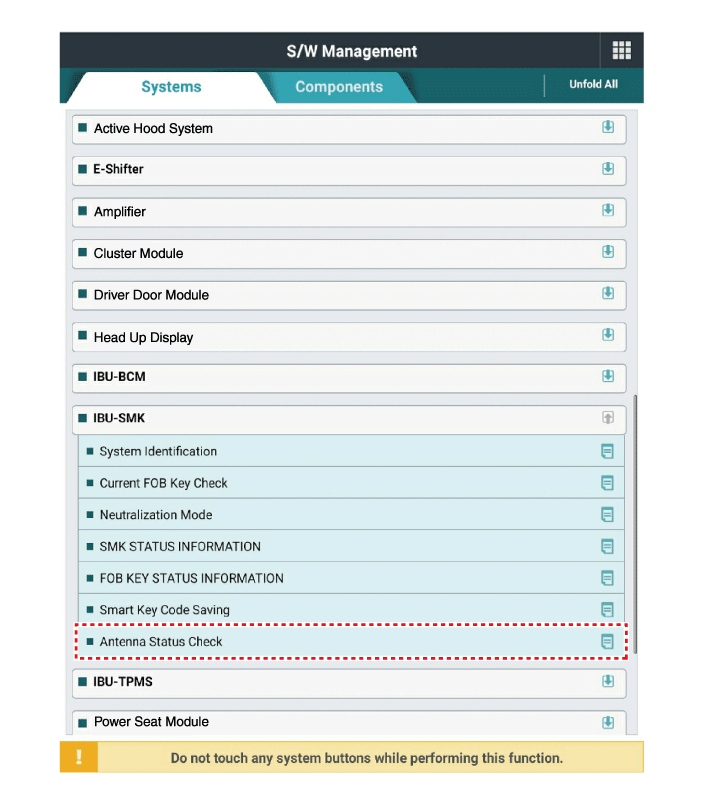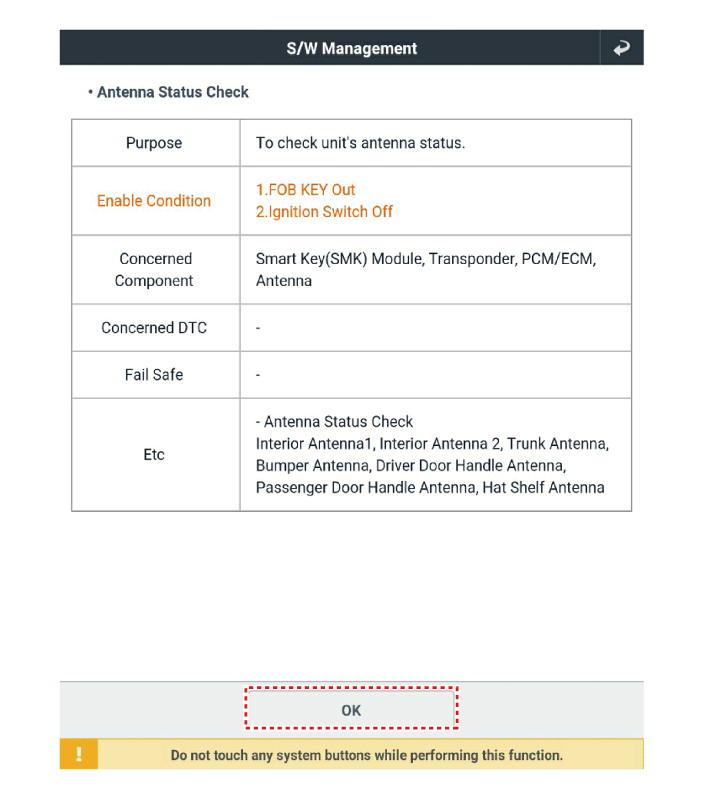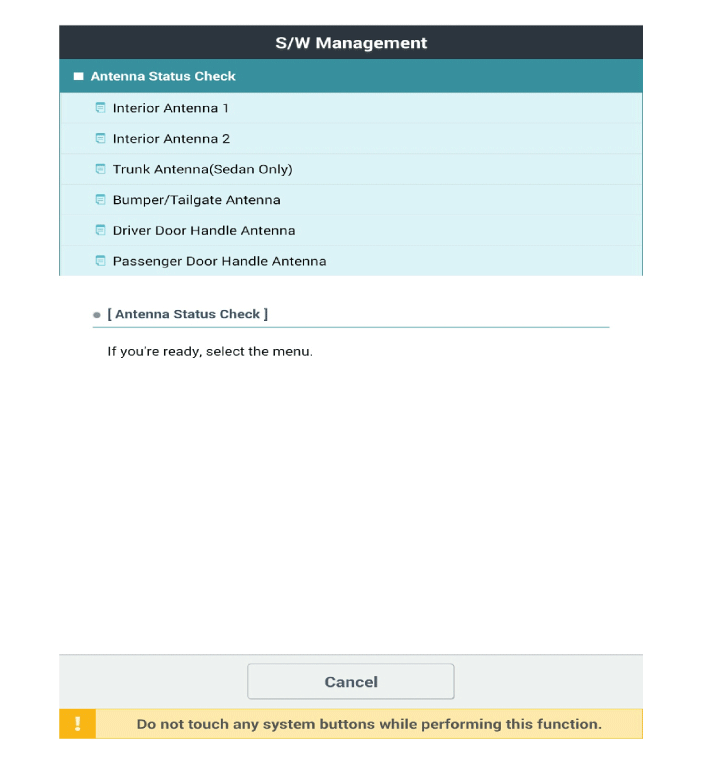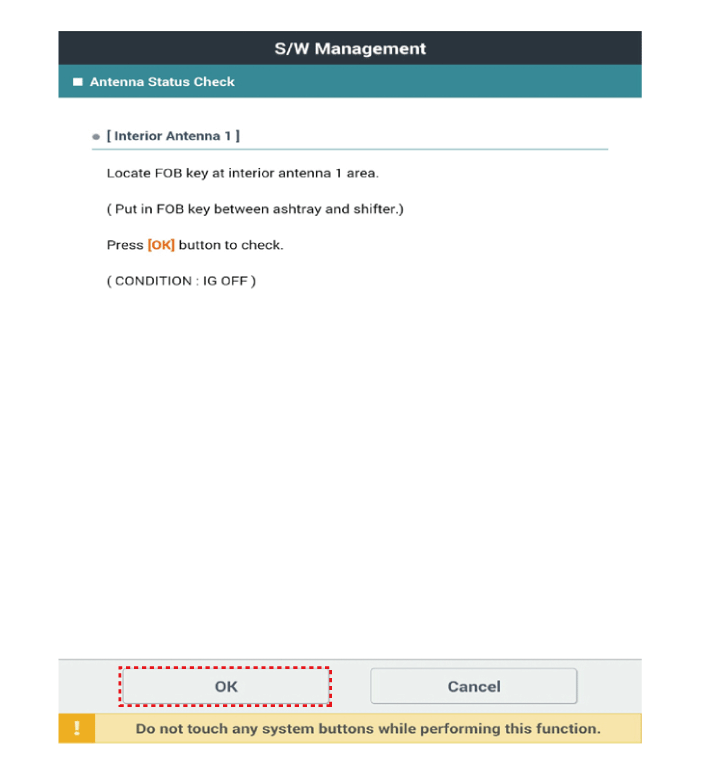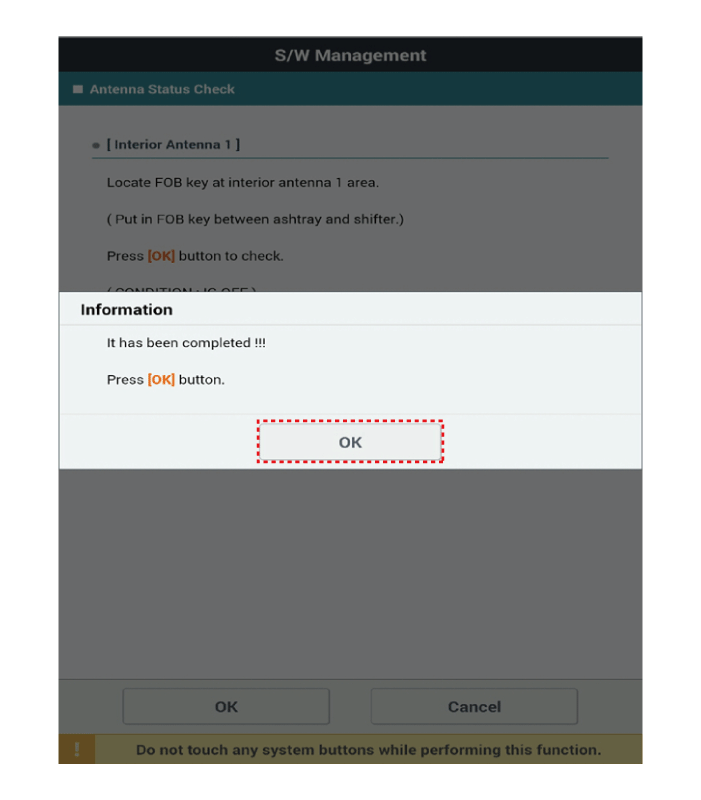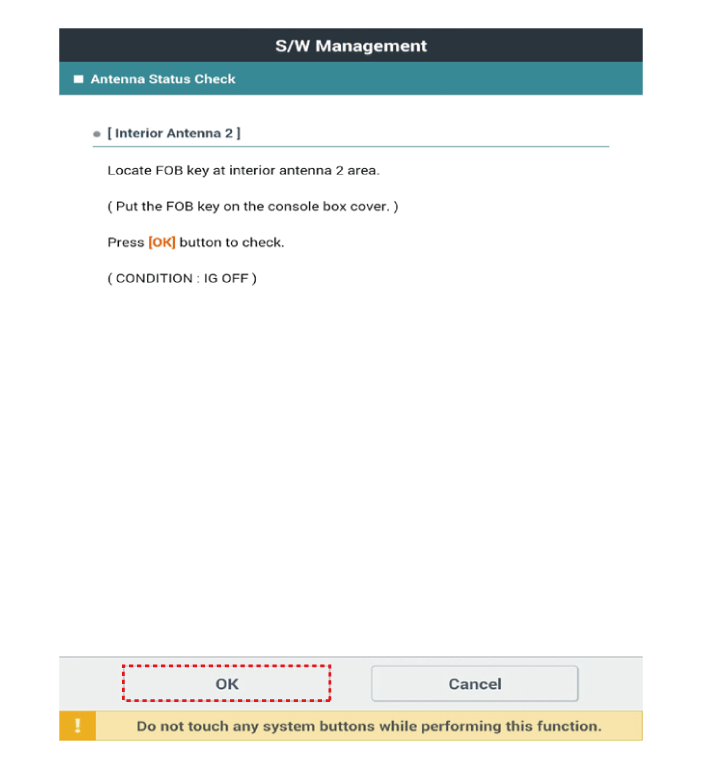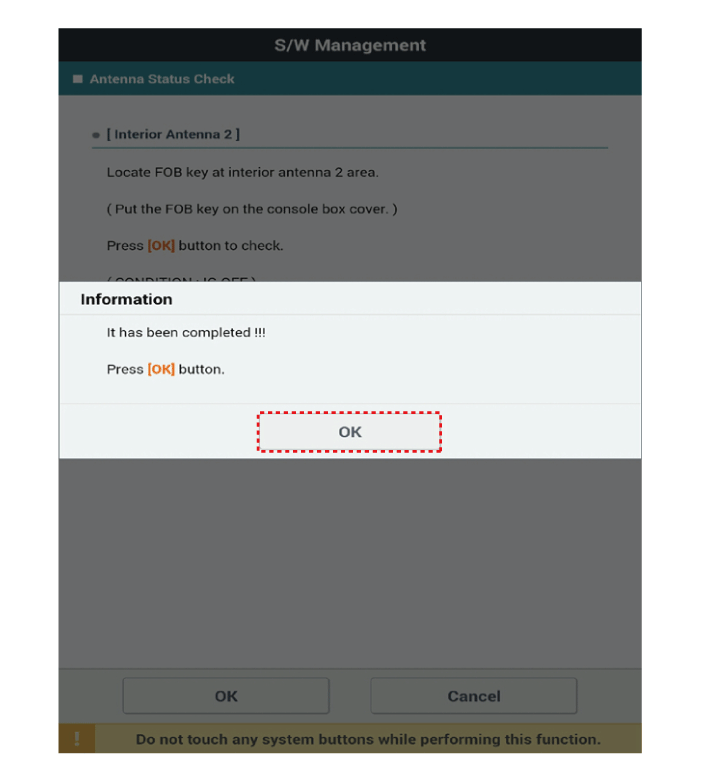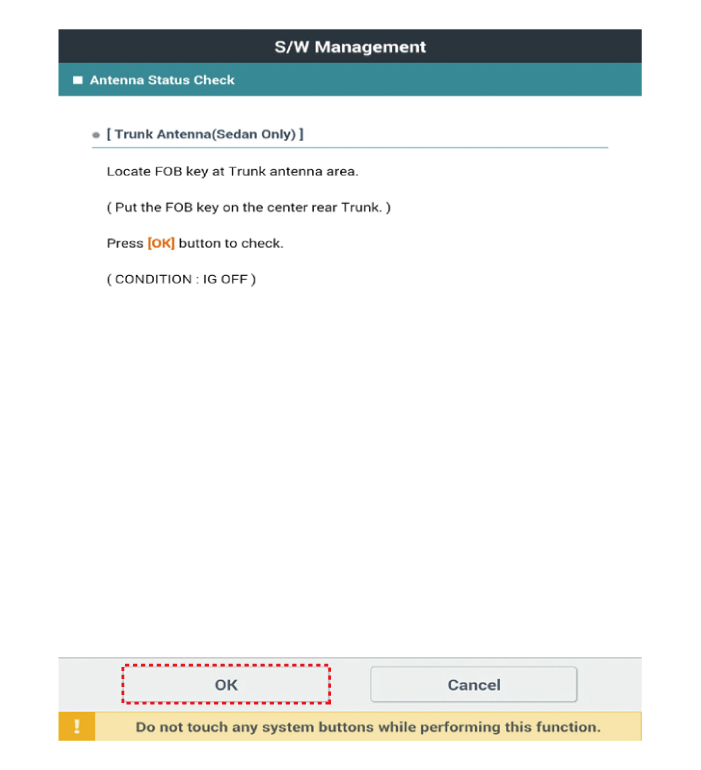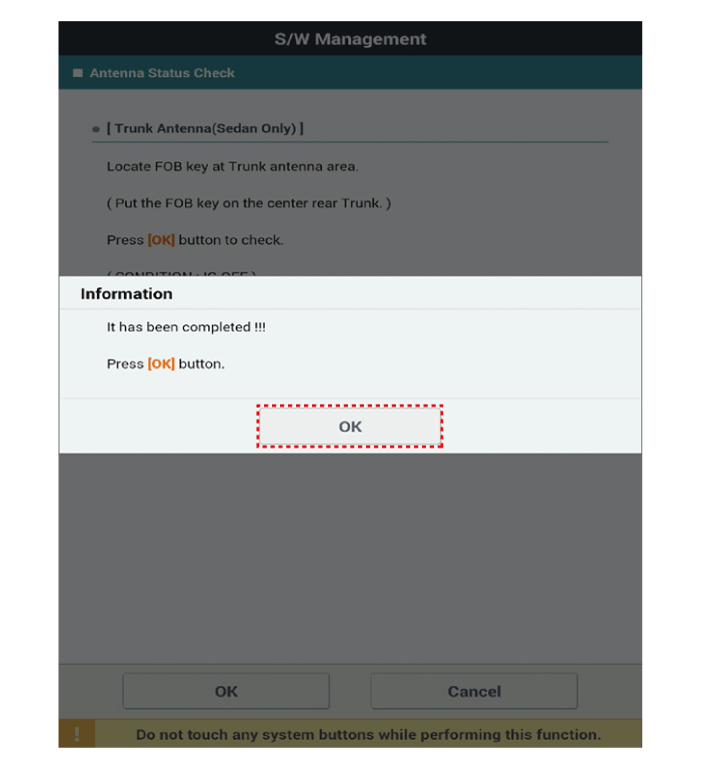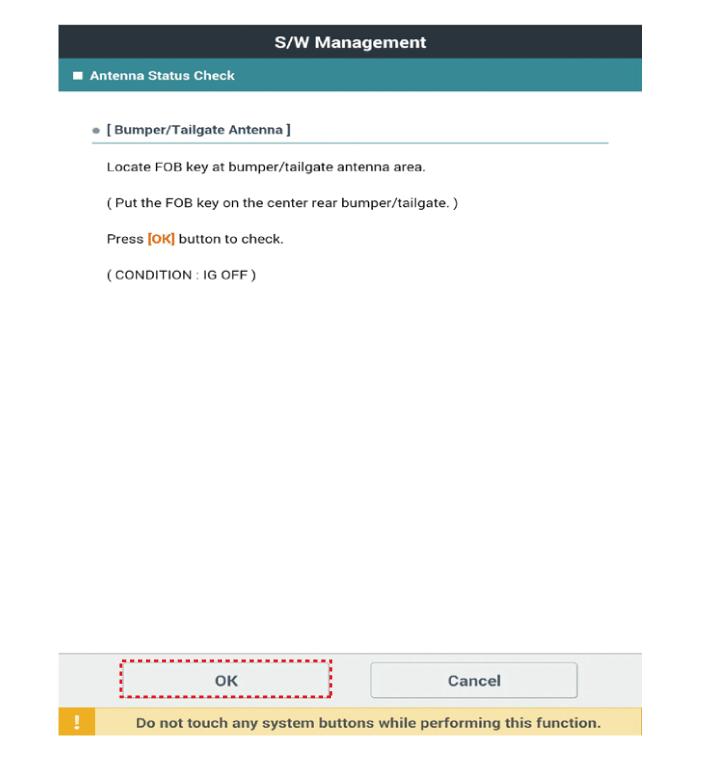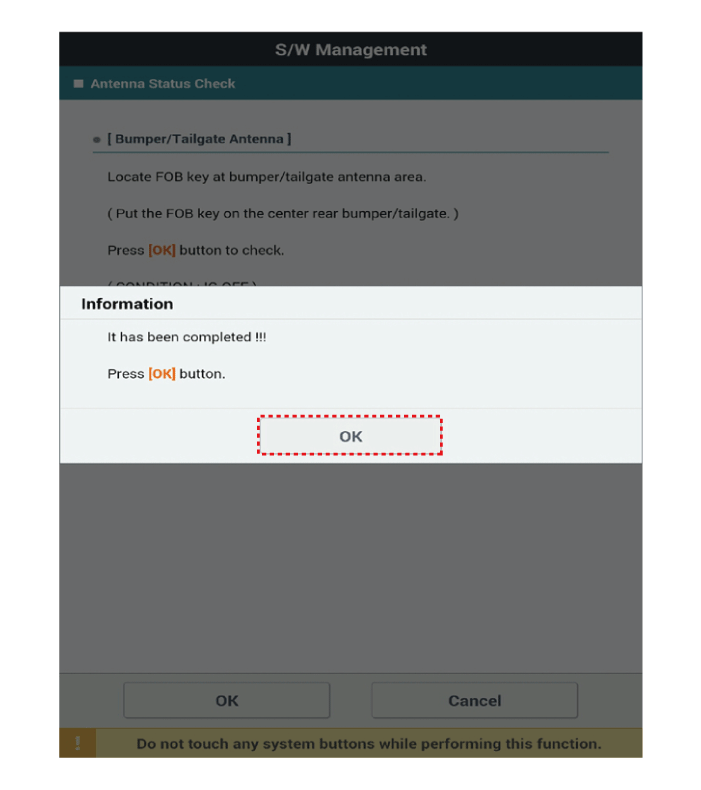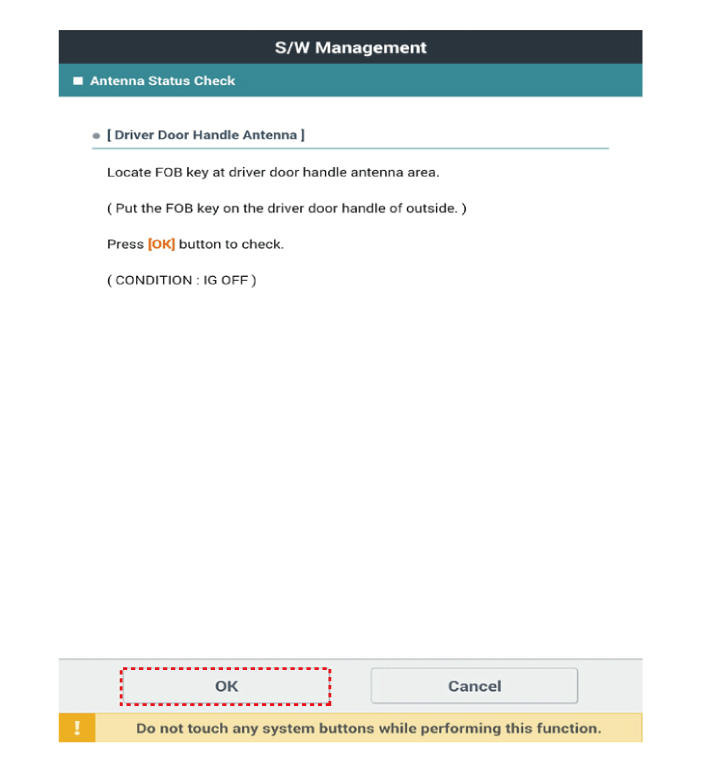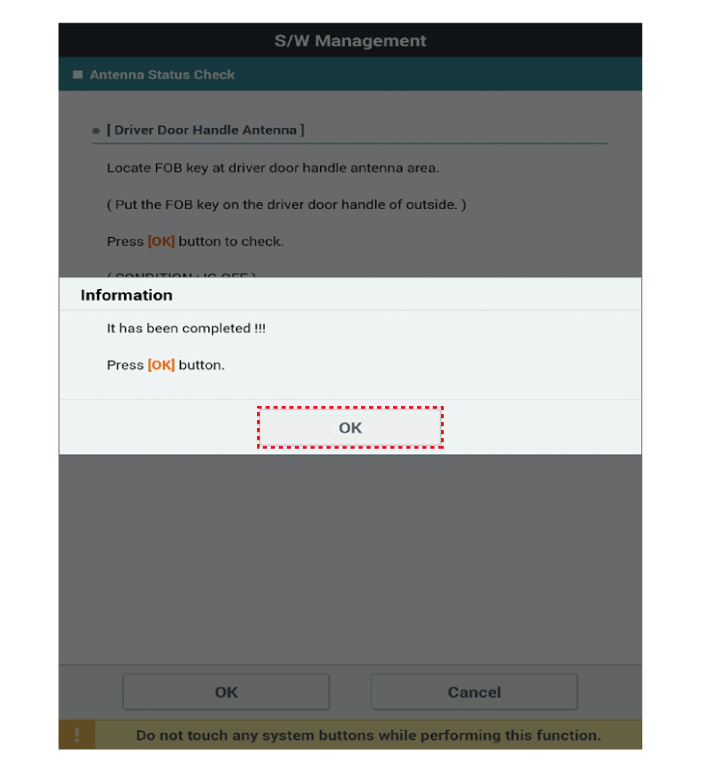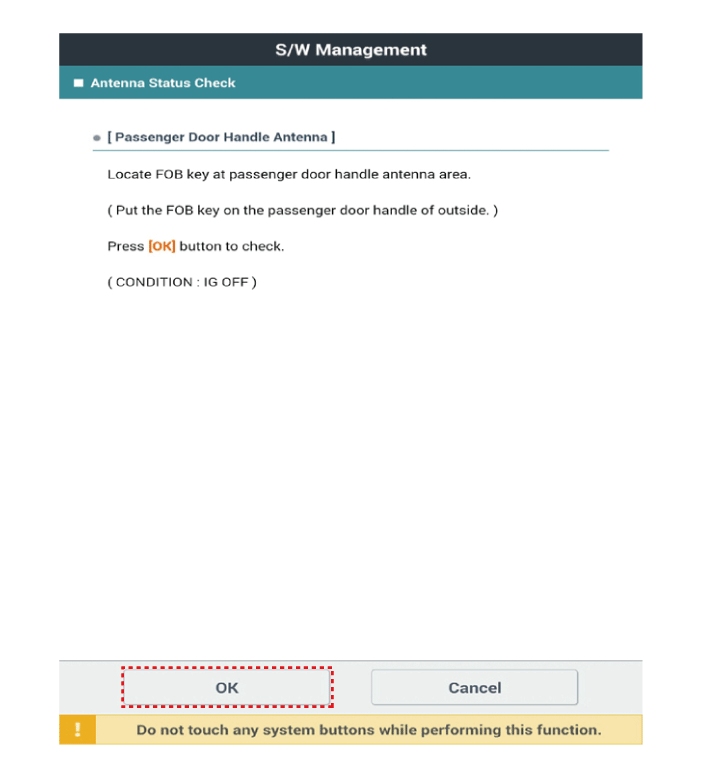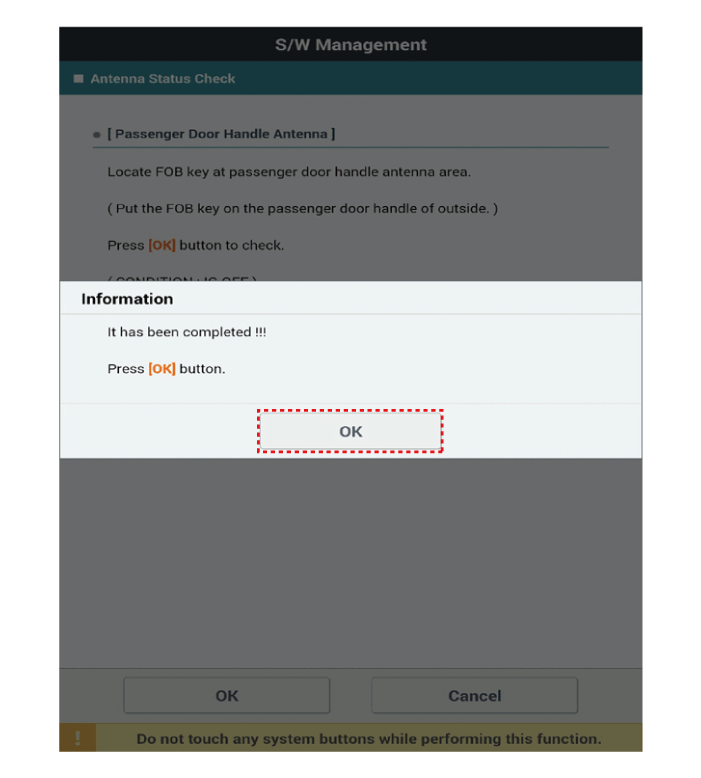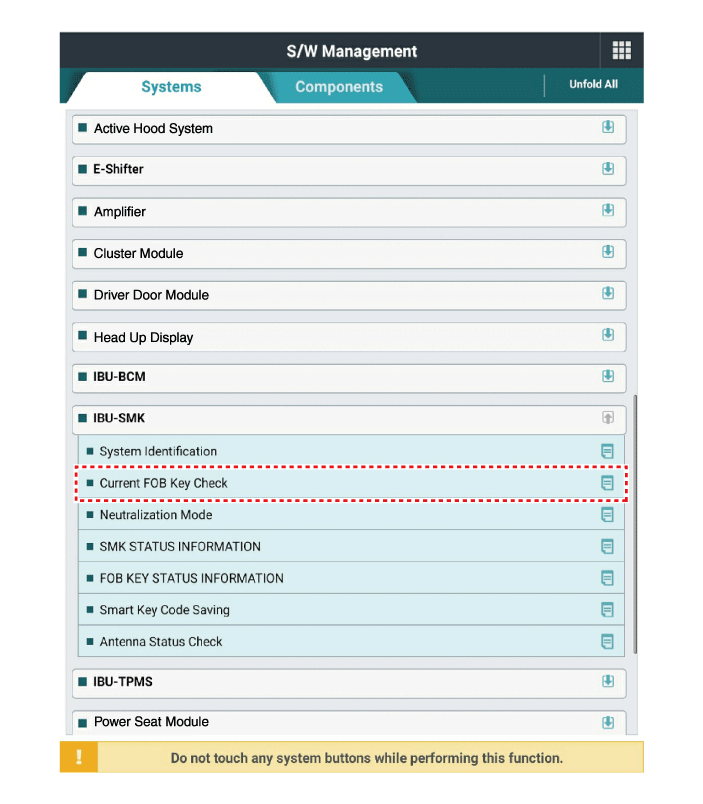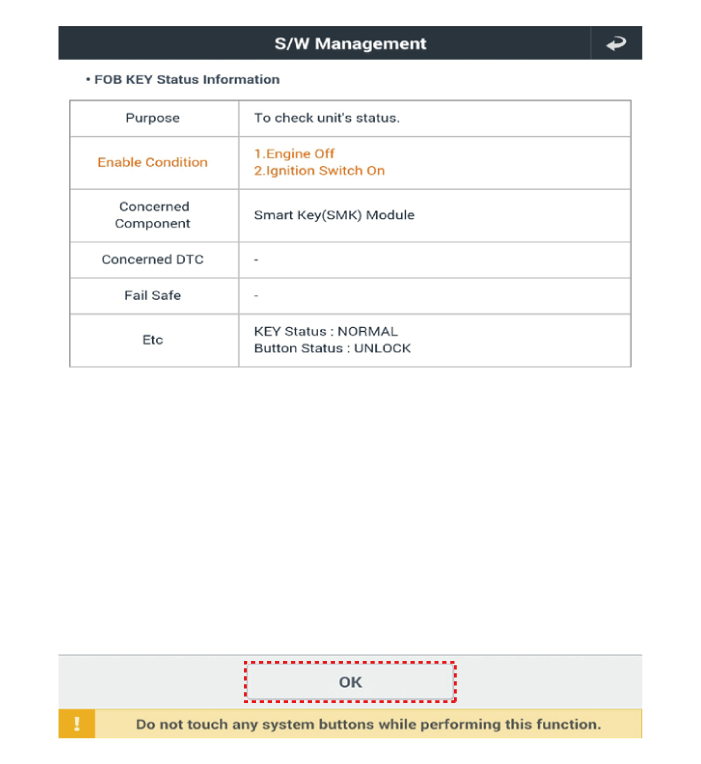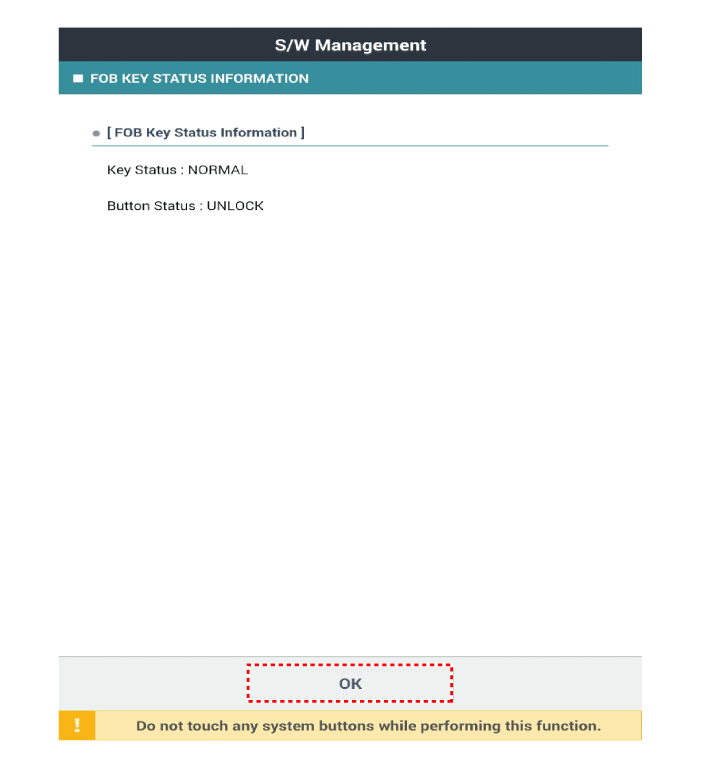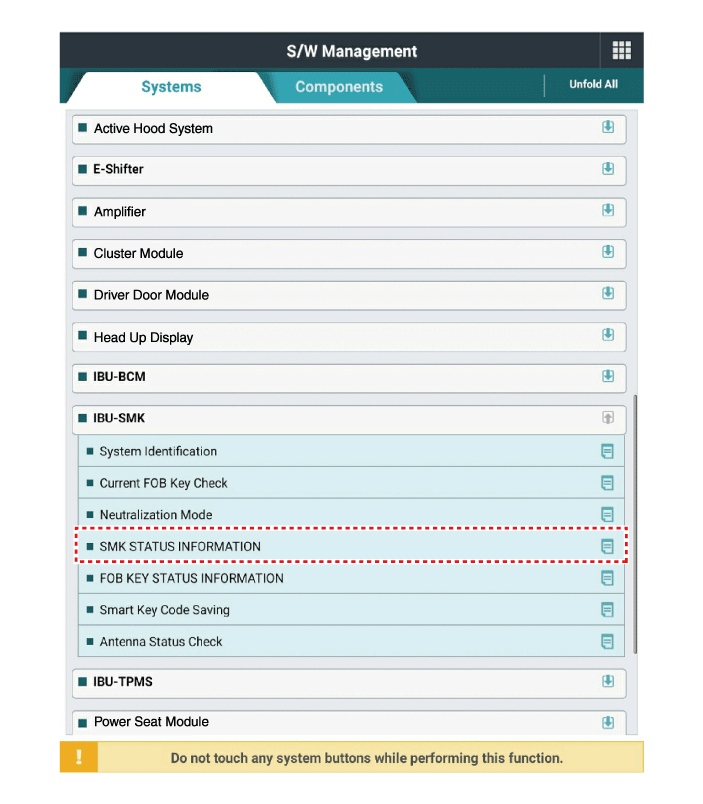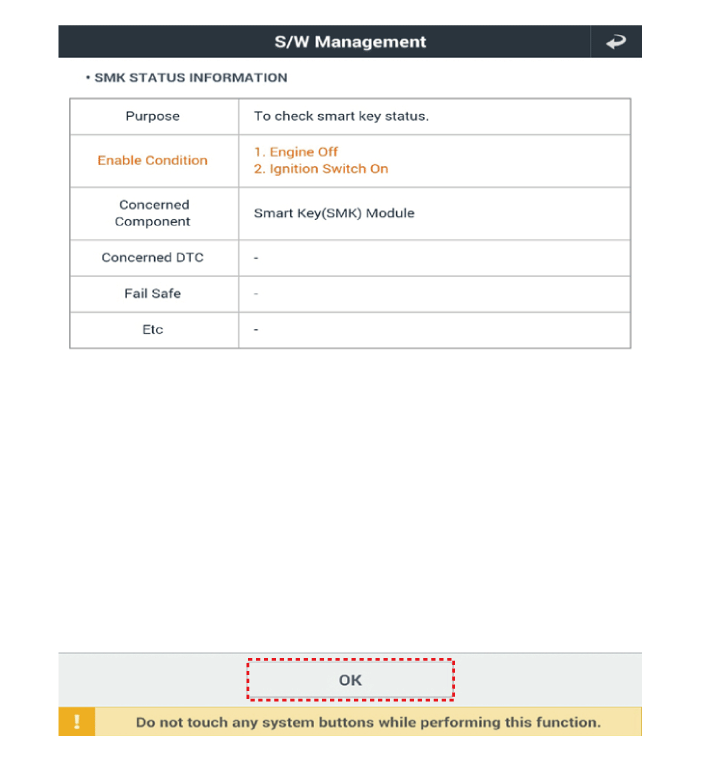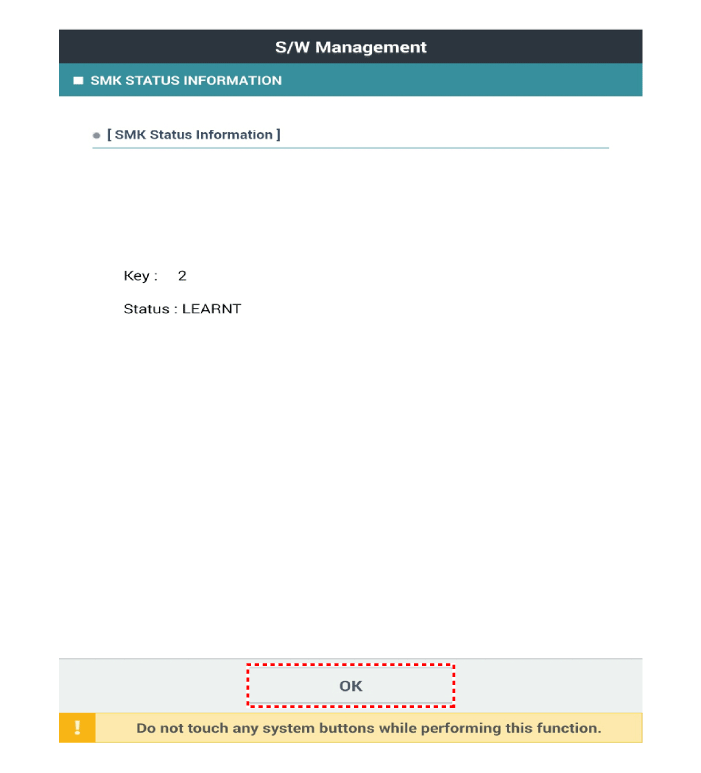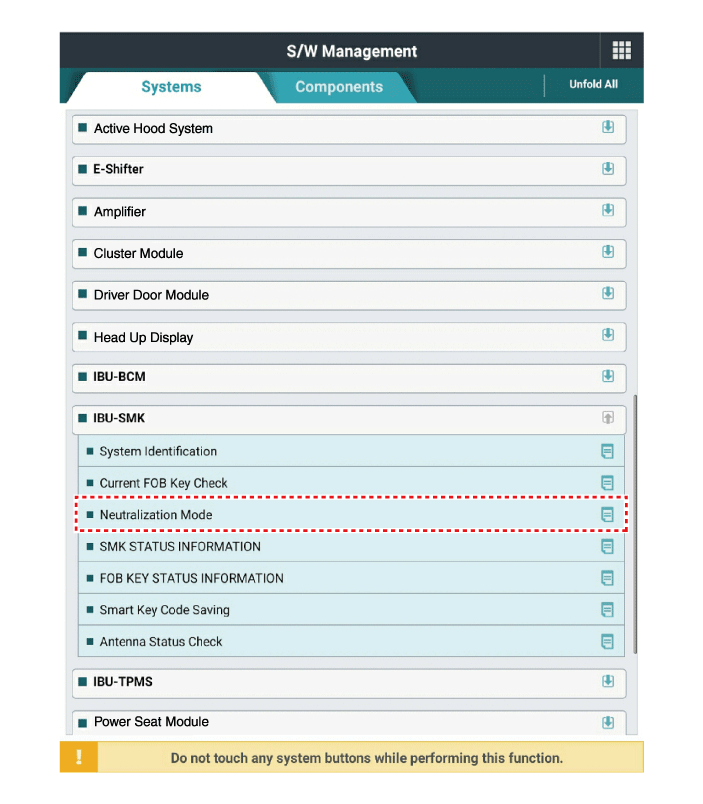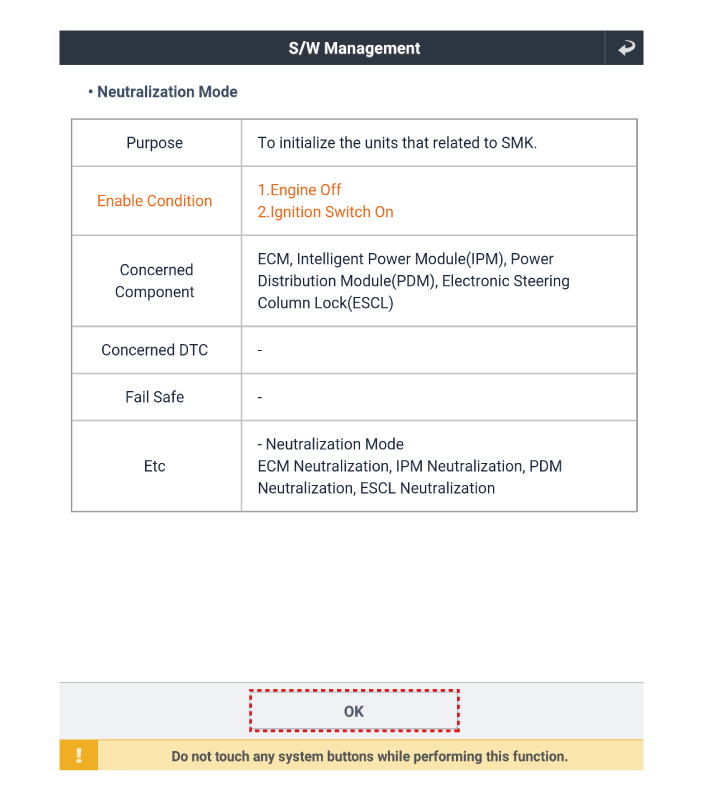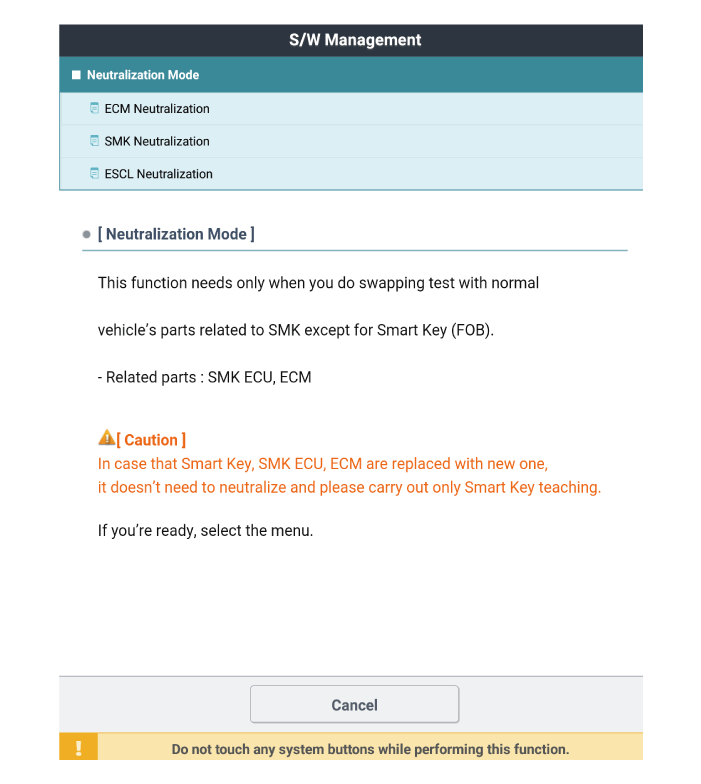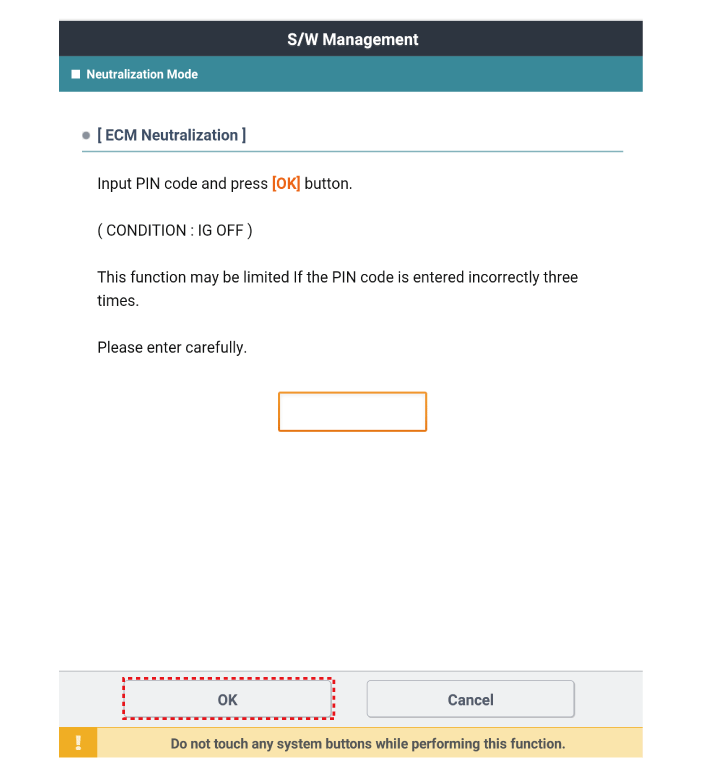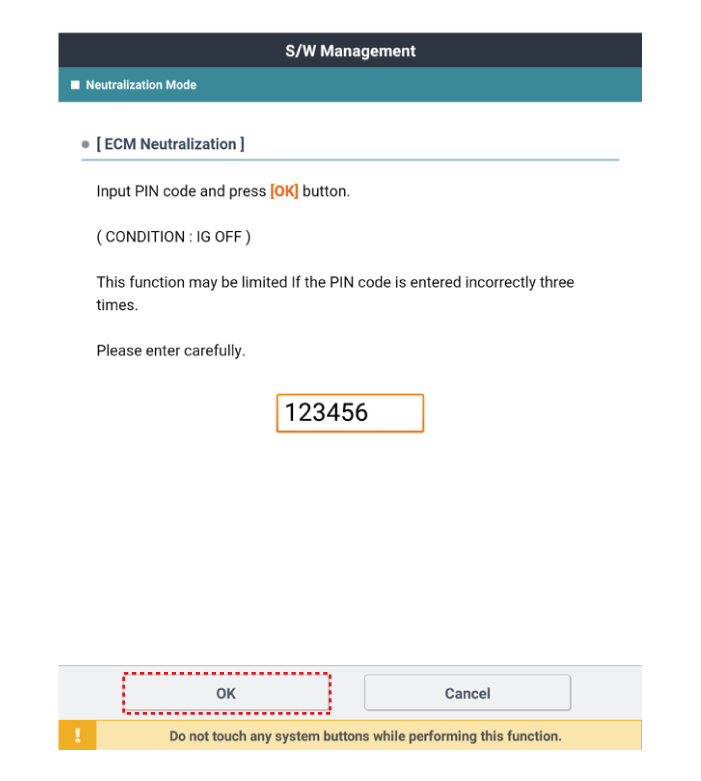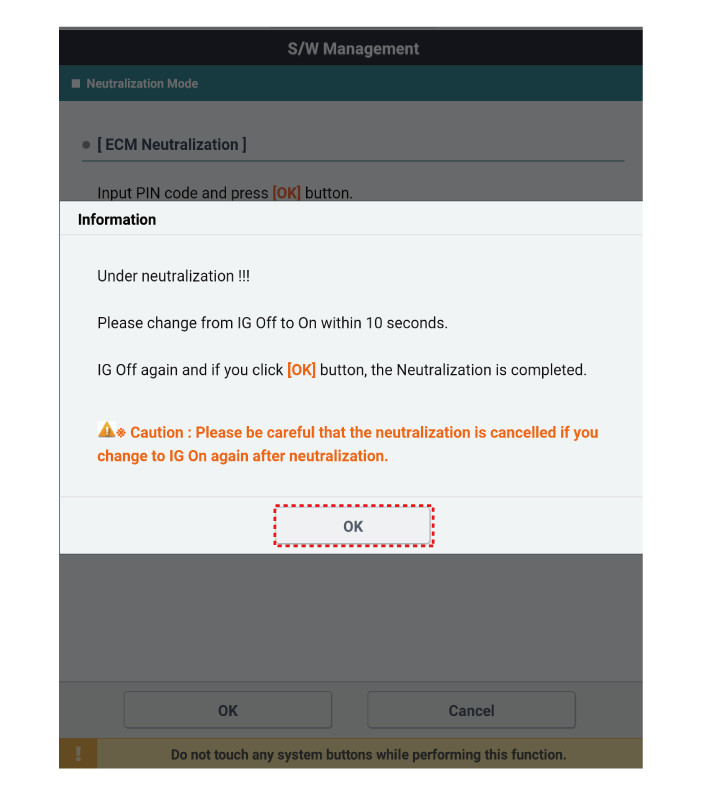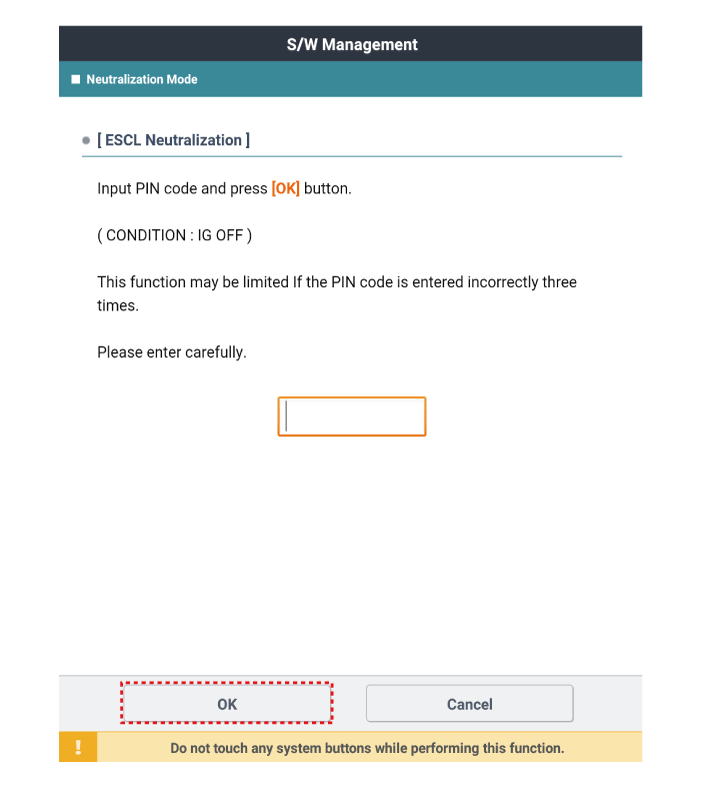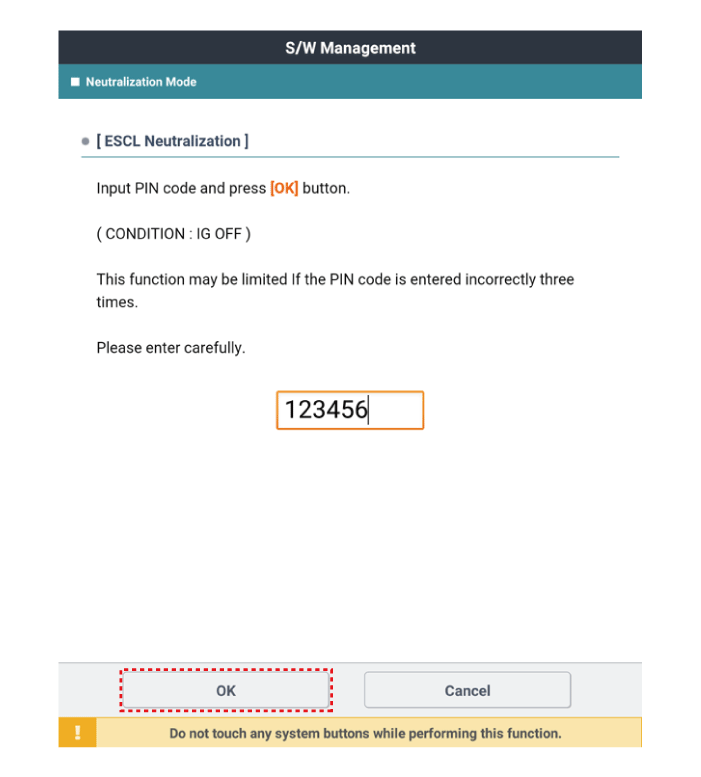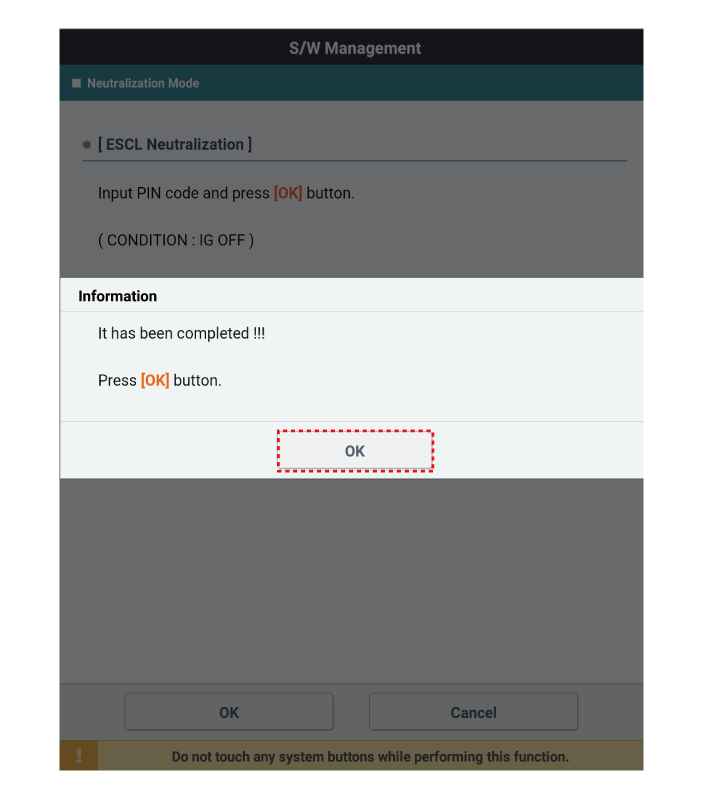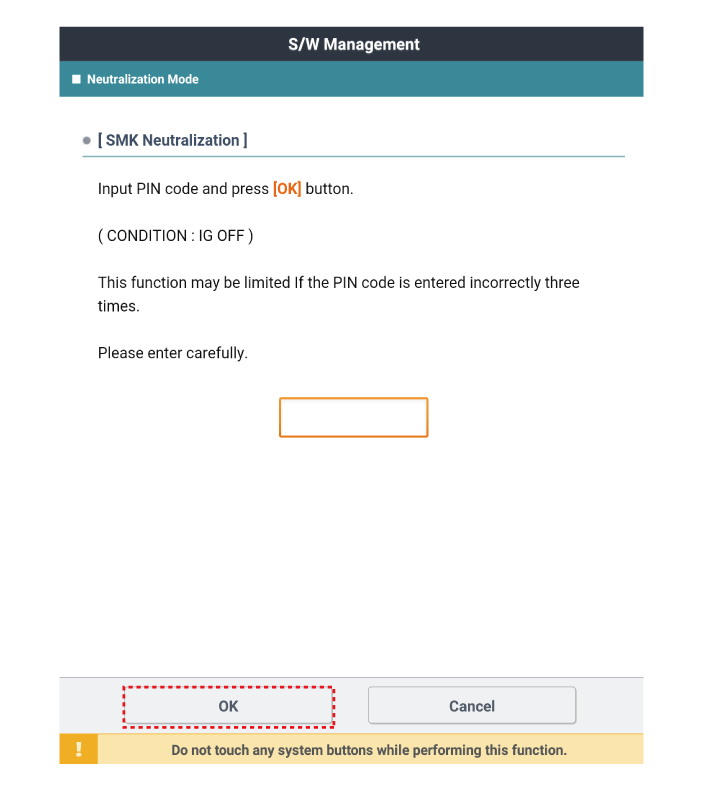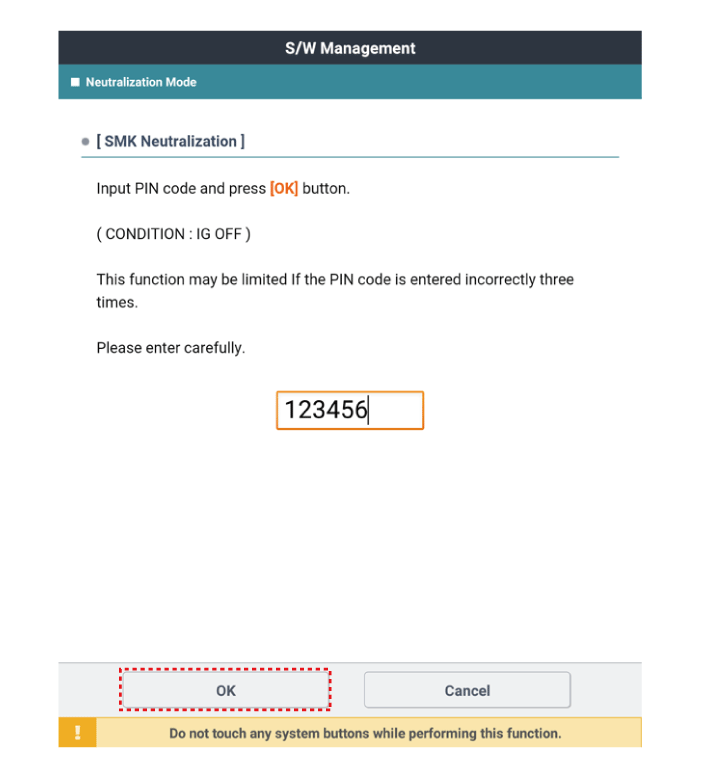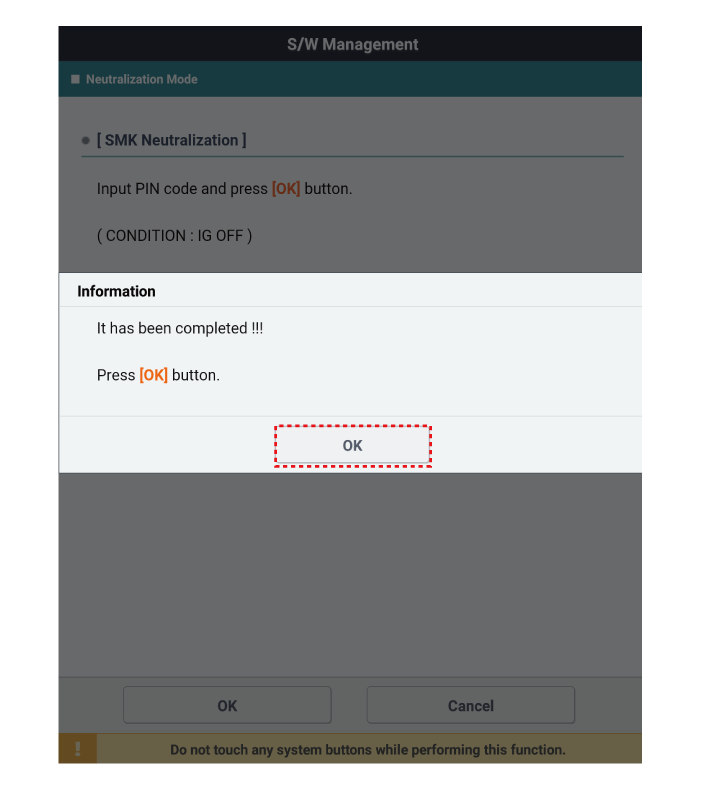Kia Forte: Body Electrical System / Smart Key System
Specifications
| Specifications |
Smart Key Unit
|
Items |
Specification |
|
Rated voltage |
DC 12 V |
|
Operation voltage |
DC 9 - 16 V |
|
Operation temperature |
-22 to 167°F (-30 to 75°C) |
RF Receiver
|
Items |
Specification |
|
Frequency |
433.92 MHz |
|
Antenna type |
FSK |
Smart Key
|
Items |
Specification |
||||||||
|
Battery |
Lithium battery 3V 1 unit |
||||||||
|
Distance |
- The distance over which RF(Radio Frequency) Receiver can receive a FOB
transmission signal : 30m - The distance over which LF(Low Frequency) antenna(Outer Handle/ Trunk/ Trunk) can detect FOB : 0.7m |
||||||||
|
Battery life |
More than 2 years (10 times / a day)
|
||||||||
|
Push buttons |
3 (Door lock / unlock, Trunk) |
||||||||
|
Frequency (Rx) |
125 kHz |
||||||||
|
Frequency (Tx) |
433.92 MHz |
||||||||
|
Numbers |
2 units |
Antenna
|
Items |
Specification |
|
Rated voltage |
DC 12 V |
|
Operating voltage |
DC 9 - 16 V |
|
Operation temperature |
-22 to 167°F (-30 to 75°C) |
|
Frequency |
125kHz |
|
Numbers |
Interior (3 units), Door (2 units), Bumper (1 unit) |
Components and components location
| Components (1) |
| [4DR] |
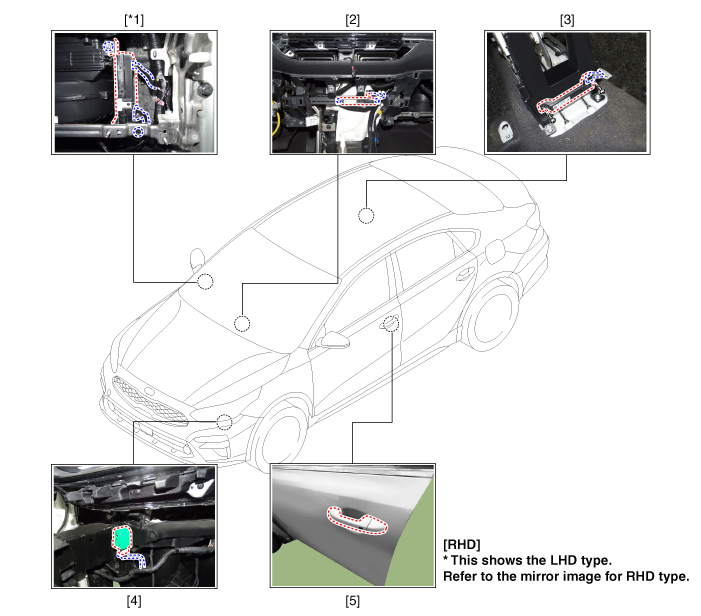
| 1. Integrated body control unit
(IBU) 2. Interior antenna 1 3. Interior antenna 2 |
4. Buzzer 5. Door handle & door antenna |
| [5DR] |
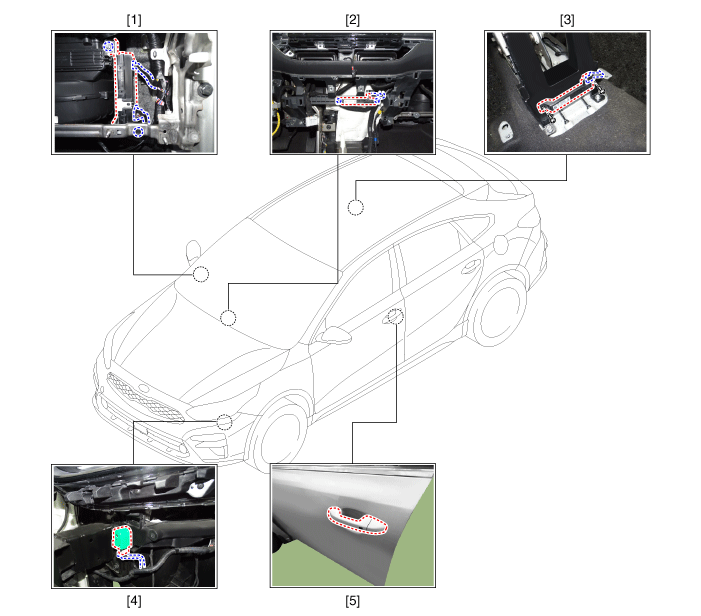
| 1. Integrated body control unit
(IBU) 2. Interior antenna 1 3. Interior antenna 2 |
4. Buzzer 5. Door handle & door antenna |
| Components (2) |
| [4DR] |
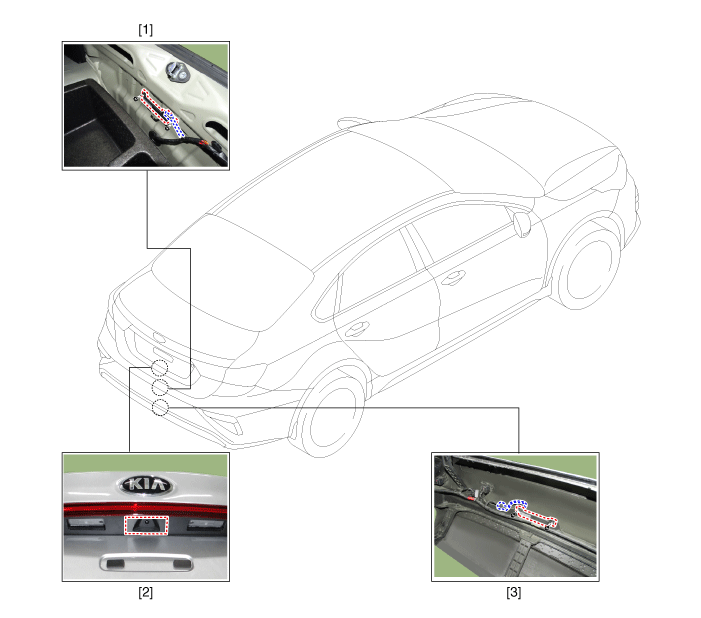
| 1. Trunk antenna 2. Trunk lid handle |
3. Bumper antenna |
| [5DR] |
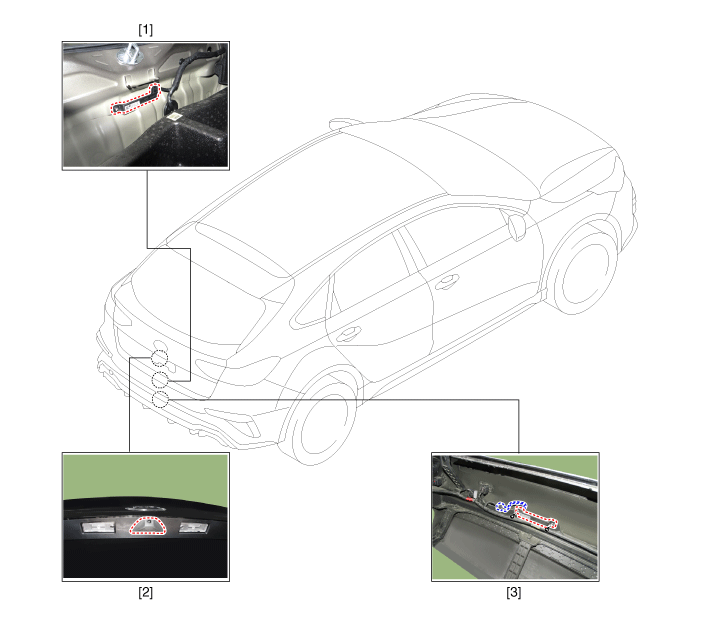
| 1. Trunk antenna 2. Trunk lid handle |
3. Bumper antenna |
Description and operation
| Description |
Block Diagram
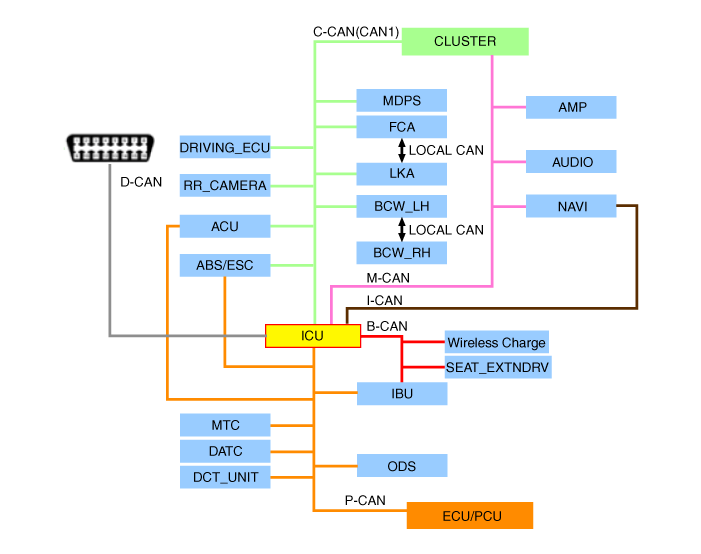
|
Abbreviation |
Abbreviation Explanation |
|
ACU |
Airbag Control Unit |
|
MDPS |
Motor Driven Power Steering |
|
LKA |
Land Keeping Assist |
|
BCW |
Blind-Spot Collision Warning |
|
IBU |
Integrated Body Control Unit |
|
ICU |
Integrated Central Control Unit |
|
MTC |
Manual Temp Control |
|
DATC |
Dual Automatic Temp Control |
|
ODS |
Occupant Detection System |
|
PCU |
Powertrain Control Module |
|
ABS |
Anti-Lock Braking System |
The SMART KEY system is a system that allows the user to access and operate a vehicle in a very convenient way. To access the vehicle, no traditional key or remote control unit is needed.
The user carries a SMART KEY FOB which does not require any conscious actions by the user (e.g. operate a RKE button). The SMART KEY system is triggered by pressing a push button in the door handle.
After being triggered the vehicle sends out a request in a limited range. If the SMART KEY FOB receives this request, it automatically sends a response to the vehicle. Then the system decides whether to perform a particular action (unlocking, locking…) or remain inactive.
Again, a communication between the vehicle and the SMART KEY FOB is needed before any actions will be performed.
The System offers the following features :
| • |
Passive unlock via 4 doors |
| • |
Passive locking via 4 doors |
| • |
Passive start |
| • |
Passive access trunk via the trunk lid switch at the trunk |
| • |
Max. 2 fobs can be handled by the system |
| • |
Immobilizer backup antenna driver integrated into SSB for TP authentication (i.e. limp home mode) |
| • |
Communication with engine management system |
| • |
Communication with SRX |
| • |
LF-RF communication |
| 1. |
Passive unlock The system allows the user to access (unlock) the vehicle without performing any actions with the SMART KEY FOB. |
| 2. |
Passive locking The system allows the user to lock the vehicle by pushing a button on door handle with the SMART KEY FOB. |
| 3. |
Button start The system allows the user to switch the power modes (Off, Accessory, Ignition), as well as to start and stop the vehicle’s engine without performing any actions with the SMART KEY FOB. See Button Engine Start system specification. |
| 4. |
LIMP HOME Mode Additionally, the system offers so called “limp home mode”, which is the user can operate all vehicle functions by pushing the key into the SSB. |
| Operation |
Passive Functions
The system allows the user to access the vehicle without having to perform any actions (e.g. RKE button pressing) with the SMART KEY FOB. It is sufficient that a valid SMART KEY FOB is located within a defined and limited range with respect to the vehicle. So the system is capable of detecting and authenticating a SMART KEY FOB in the ranges as specified below.
| Operating Range |
The SMART KEY FOB receives and interprets a challenge sent from the vehicle via the exterior antennas in a free space range of min. 0.7 m measured around the exterior antennas which are integrated in the door handles.
The trunk or trunk access range is also min. 0.7 m measured from the antenna position.
Passive Access (Passive Entry)
Pressing one of the push buttons in the door handles when all doors are locked indicates the operator's intention to access the vehicle and thus triggers the system to unlock.
Passive Locking (Exit)
Press one of the push buttons in the door handles when one of the following conditions is fulfilled:
| • |
At least one door is unlocked and two-step timer is not running or. |
| • |
Two-step timer is running and one of the push buttons except the front left-hand side is triggered to indicate the operator's intention to lock the vehicle and thus trigger the system to lock. |
Passive Trunk Warning (Sedan only)
Whenever the trunk is closed, SMK ECU uses a suitable search strategy to avoid trunk buzzer warning by a fob outside the vehicle. Then SMK searches for a SMART KEY FOB in the interior of the trunk. If a valid SMART KEY FOB is found in the trunk, the SMK ECU activates SMK external buzzer (TBD) to inform the user that the trunk has been closed with a fob inside the trunk.
SMK will send the trunk open command to IBU for trunk reopening if trunk reopening bit is set (BK). For this functionality, a “valid” SMART KEY FOB means any SMART KEY FOB that belongs to the vehicle, even if it’s DEACTIVATED.
|
Smart Trunk
When a valid smart key stays near the rear bumper (within LF antenna range) for over 3 seconds, trunk will be opened.
Activate the 'handsfree trunk' function from the User Setting Mode (USM) of the cluster. |
| 1. |
Rear bumper antenna constantly detects for a valid smart key nearby. |
| 2. |
If a valid smart key enters the rear bumper antenna range, the buzzer and hazard lamp will be activated once.
|
| 3. |
If the Smart Key remains in the rear bumper detection range (antenna range) for over 3 seconds, alert buzzer and hazard lamp will be activated twice and the trunk will be opened. |
Welcome Light
When a driver holding a smart key approaches the vehicle, the door mirrors and puddle lamps will be controlled by smart key authentication.
| 1. |
Access to welcome light search mode (Mode that regularly searches for smart key to prevent discharge of vehicle battery)
|
| 2. |
Welcome light ON
|
Smart Key Reminder 1
| 1. |
Preconditions:
|
| 2. |
Event:
If no fob or no TP has been found, no action is required. If any valid fob or valid TP has been found, SMK unlocks the vehicle by sending a CAN Key Reminder unlock message with the fob number. If any valid fob has been found, SMK unlocks the vehicle by sending a CAN/LIN Key Reminder unlock message with the fob number. |
Smart Key Reminder 2
| 1. |
Preconditions:
|
| 2. |
Vehicle action: Closes the last door or trunk with knobs in locked state or with locking in progress |
| 3. |
SMK actions: Checks the locking status for 500 ms after closing the door. If all doors are locked:
If no fob has been found, no action is required. If any valid fob has been found, SMK sends unlock command via CAN/LIN and activates ext. buzzer warning. |
Smart Key Door Lock Warning
Door Lock Warning 1
| 1. |
If terminal state is ACC or IGN, all doors are closed and user triggers SMK lock, searching starts at the exterior of the vehicle from the side of the trigger. |
| 2. |
If no valid Fob is found, no action is required, but if a valid Fob is found, then a Buzzer warning shall be started. |
| 3. |
If the following conditions are fulfilled, the lock warning regards the trunk as a door and trunk lock/unlock knob as a door unlock switch:
|
Door Lock Warning 2
| 1. |
If terminal state is OFF, not all doors are closed, and user triggers SMK lock, searching starts at the exterior of the vehicle from the side of the trigger. |
| 2. |
If no valid Fob is found, no action is required, but if a valid Fob is found, then a Buzzer warning shall be started. |
| 3. |
If the following conditions are fulfilled, the lock warning regards the trunk as a door and trunk lock/unlock knob as a door unlock switch:
|
Door Lock Warning 3
| 1. |
If terminal state is OFF, ATWS is considered as Disarmed, all doors are closed, and user triggers SMK lock, searching will start from the interior of the vehicle. |
| 2. |
If no valid Fob is found, the search for SMK locking will start, but if a valid Fob is found, then a Buzzer warning will start. |
| 3. |
If the following conditions are fulfilled, the lock warning regards the trunk as a door and trunk lock/unlock knob as a door unlock switch:
|
Smart key Lamp Warning
| 1. |
If terminal state is in ACC or IGN and vehicle speed is less than 3 km/h, a periodic search (for every 3 seconds) is performed from the interior of the vehicle to check that a valid fob is still in the vehicle. |
| 2. |
If no valid Fob is found, a warning goes off, but if a valid Fob is found, no action is initiated. |
Failsafe Functions (Backup For Limp Home)
In case of a discharged battery of the SMART KEY FOB or disturbed transmission, the following functions are available:
| • |
Unlocking / locking of doors or trunk: use of mechanical key. |
User Information Functions
| ID OUT Warning |
| 1. |
Preconditions :
|
| 2. |
Event: The last opened door is closed. |
| 3. |
SMK action: SMK searches for a SMART KEY FOB from the interior.
|
If there is an LF error (LF overheating or LF antenna failure), the system will behave in the same way as when no fob has been found. |
Fob Battery Low Voltage Detection
To detect fob low battery condition, certain battery voltage measurement and low voltage detection strategy are implemented into fob. The measurement of the battery voltage will be done if fob button is pressed or if an LF measurement command is received.
Learning Description
In this chapter, the learning procedure for SMK and FOB is explained.
For the learning of the SMK and FOBs, it's necessary to have a connection to the diagnostic tool.
Learning MODE
Whatever the mode, the learning procedures are managed by the SMK.
Prior to start learning service, Fob-In signal must be active and the vehicle secret code (referred to as PIN code) should be known.
Teaching Mode
This mode is used by dealers to replace SMK and/or the set of keys, or to register additional keys for an existing system. In this case, the system has already learnt certain PIN Code. The PIN Code is fixed for the lifetime of the vehicle, therefore, the same PIN Code must be used in this mode. Otherwise, learning will fail.
Teaching MODE Procedure Description (Step By Step)
Objective : Key teaching procedure at service station
Initial state :
| – |
SMK replacement: SMK is not learnt and SMART FOB are already learnt with same PIN code |
| – |
Teaching additional or new keys: SMK and ESCL are already learnt with same PIN code |
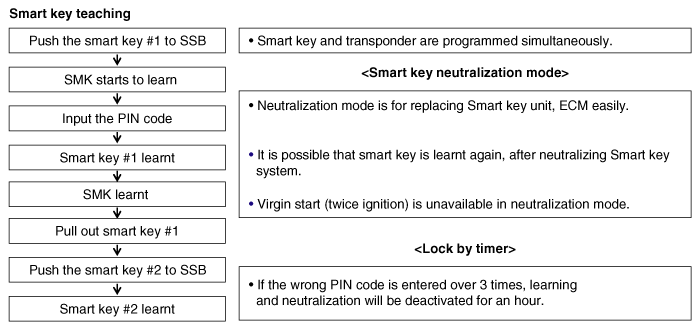
Starting After Replacing (Virgin Start)
Starting is possible in the following process after replacing with a new smart key unit or FOB key.
| • |
This method is used when starting in virgin condition. |
| • |
All related parts are in virgin condition (Smart key, PCM). |
| • |
Press brake pedal in P or N range. |
| • |
Push the start button once with virgin smart key. |

Repair procedures
| Inspection |
| 1. |
In the body electrical system, failure can be quickly diagnosed by using the vehicle diagnostic system (KDS). The diagnostic system (KDS) provides the following information.
|
| 2. |
Select the "Car model" and the 'IBU-SMK' to be checked in order to check the vehicle with the tester. |
| 3. |
Select the 'Current Data' menu to search the current state of the input/output data. |
| 4. |
If you want to check each module operation forcefully, select "Actuation test". |
Antenna Actuation Diagnosis
| 1. |
Connect the cable of KDS to the data link connector in driver side crash pad lower panel. |
| 2. |
After IG ON, select the "Actation Test". |
| 3. |
Set the smart key near the related antenna and operate it with a KDS. |
| 4. |
If the LED of smart key is blinking, the smart key is normal. |
| 5. |
If the LED of smart key is not blinking, check the voltage of smart key battery. |
| 6. |
Antenna actuation
|
Antenna Status Check
| 1. |
Connect the cable of KDS to the data link connector in driver side crash pad lower panel. |
| 2. |
Select the "Antenna Status Check".
|
| 3. |
After IG ON, select the "Antenna Status Check".
|
| 4. |
Set the smart key near the related antenna and operate it with a KDS.
|
| 5. |
If the smart key runs normal , the related antenna, smart key(transmission, reception) and exterior receiver are normal. |
| 6. |
Antenna status
|
FOB Status Check
| 1. |
Connect the cable of KDS to the data link connector in driver side crash pad lower panel. |
| 2. |
After IG ON, select the "FOB KEY STATUS INFO".
|
Smart Key Status Check
| 1. |
Connect the cable of KDS to the data link connector in driver side crash pad lower panel. |
| 2. |
After IG ON, select the "SMK STATUS INFO".
|
Neutralization Status Check
| 1. |
Connect the cable of KDS to the data link connector in driver side crash pad lower panel. |
| 2. |
After IG ON, select the "Neutralization mode".
|
 Power Seat Motor
Power Seat Motor
Components and components location
Components
1. Lumber support motor
2. Reclining motor
3. Front height motor
4. Rear height motor
5. Slide motor
...
 Smart Key
Smart Key
Repair procedures
Smart Key
Smart Key Code Saving
1.
Connect the VCIⅡ of KDS to the data link connector (16 pins) in driver
side crash pad lower panel, turn the pow ...
Other information:
Kia Forte 2019-2025 (BD) Service Manual: Rear Suspension System - Multi link
Components and components location Components Location 1. Rear upper arm 2. Assist arm 3. Rear cross member 4. Rear stabilizer bar 5. Trailing arm 6. Rear lower arm 7. Rear coil spring 8. Rear shock absorber ...
Kia Forte 2019-2025 (BD) Service Manual: Clutch Master Cylinder
Components and components location Components [Gasoline 1.6] 1. Clutch pedal assembly 2. Clutch pedal arm 3. Ignition lock & Clutch switch 4. Clutch master cylinder 5. Reservoir hose 6. Clutch tube [Gasoline 2.0] ...



